Goalkeeper Manuel Neuer
| Photo (detail): © Picture Alliance/R4341
Are you familiar with the “50+1” rule? Do you know who Bert Trautmann was? We present six interesting and curious facts about football in Germany.
The man in goal? A titan!
Germany has probably produced more outstanding goalkeepers than any other country: from Toni Turek, who rescued the DFB team’s World Cup victory over Hungary in 1954, and World Cup goalie Sepp Maier, to the “titan” Oliver Kahn and the DFB’s current captain and World Cup winner Manuel Neuer. Goalkeepers are worshipped in Germany. All the same, one of the greatest German goalies of all time was hardly known at all in Germany during his active period as a footballer: during the Second World War, Bert Trautmann from Bremen ended up as a British prisoner-of-war. When released, he decided to stay on in England rather than returning to Germany. He played over 500 times for Manchester City, was named England’s footballer of the year in 1956 – and became a legend: despite breaking his neck during the final of the British Football Association Challenge Cup that same year, he continued playing right to the end – ensuring that his team won the title.
Winning? It’s all that counts!
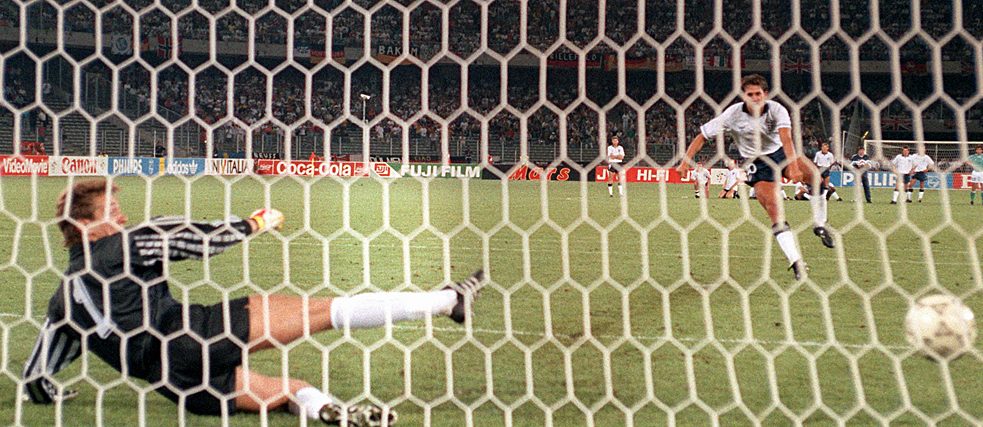 1990 World Cup: in the penalty shoot-out, English centre-forward Gary Lineker (right) beats Bodo Illgner to make it 1:0, though England ultimately loses 4:3. | Photo (detail): © Picture Alliance/Frank Leonhardt
1990 World Cup: in the penalty shoot-out, English centre-forward Gary Lineker (right) beats Bodo Illgner to make it 1:0, though England ultimately loses 4:3. | Photo (detail): © Picture Alliance/Frank Leonhardt
England is the motherland of football. And yet the prevailing wisdom there appears to be that the Germans always win! This at least is what Gary Lineker claimed. After his team was defeated by Germany in the semi-final of the 1990 World Cup, the former England player and current TV pundit summed up resignedly: “Football is a simple game. 22 men chase a ball for 90 minutes and at the end, the Germans always win”. At the time, the Germans would rarely play beautiful football, but they were often very successful. This view, accepted around the world, only began to change a few years ago when the German squad started adopting a more spectacular and offensive style.
“50+1”? Yes, please!
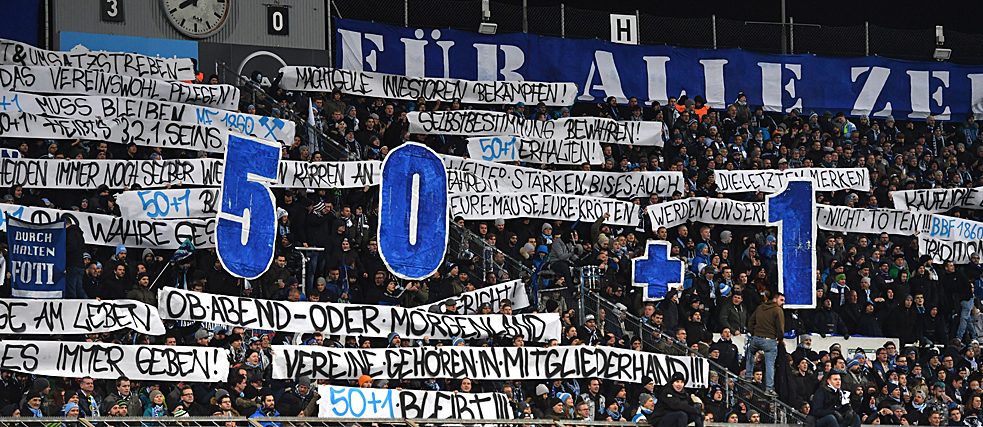 Munich fans demonstrate for the “50+1” rule to be preserved. | Photo (detail): © Picture Alliance/Sven Simon
Munich fans demonstrate for the “50+1” rule to be preserved. | Photo (detail): © Picture Alliance/Sven Simon
Whether they happen to be in England, Spain or Italy – many clubs in the world’s major leagues have long been owned by international corporations, Russian oligarchs or Arab sheikhs. This is not the case in Germany, where the so-called “50+1” rule applies in the Bundesliga: a club must hold at least 50 percent of its own voting rights in its professional division. This means that investors can never acquire full control of a club. However, some German clubs fear that this could put them at an economic disadvantage vis-à-vis the international competition. Others, such as Bayer Leverkusen and RB Leipzig, take advantage of exceptions or cleverly designed organizational structures to circumvent the regulation, which is virtually unique worldwide. Only in Austria is a comparable rule in place.
Success? It’s the women!
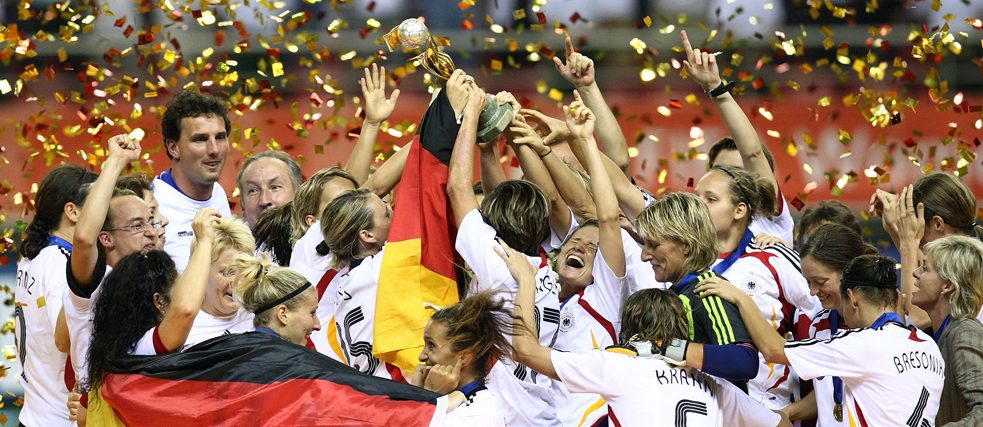 Nach dem Finale gegen Brasilien: Die deutsche Frauennationalmannschaft freut sich 2007 über den Weltmeisterschaftstitel. | Foto (Ausschnitt): © Picture Alliance/Pressefoto Ulmer
Nach dem Finale gegen Brasilien: Die deutsche Frauennationalmannschaft freut sich 2007 über den Weltmeisterschaftstitel. | Foto (Ausschnitt): © Picture Alliance/Pressefoto Ulmer
Only Germany’s women footballers are more successful than their male counterparts. The DFB squad has already won the World Cup twice, despite there having only been seven championships for women so far. The DFB women have already won the European Championships eight times. They also won gold at the Rio de Janeiro Olympics in 2016 – something the DFB men have never achieved. Incidentally, the only Olympic victory of a German men’s team was also the greatest success in East German football: the GDR squad featuring the legendary Dresden playmaker Hans-Jürgen “Dixie” Dörner beat Poland in the final of the 1976 Montreal Olympics.
Germany? Two is better than one!
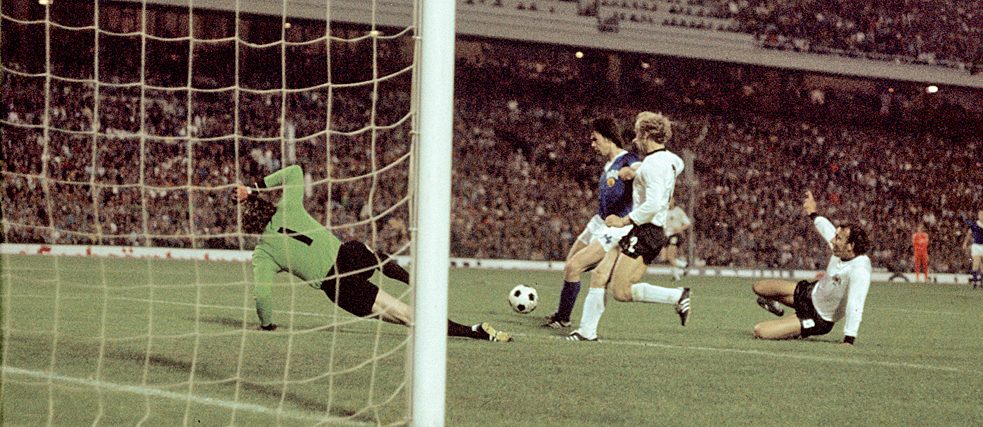 DDR-Stürmer Jürgen Sparwasser (2.v.l.) erzielt, vorbei am Abwehrspieler Berti Vogts (2.v.r.) und Torhüter Sepp Maier (l.), die 1:0-Führung gegen das BRD-Team. | Foto (Ausschnitt): © Picture Alliance/Werner Schulze
DDR-Stürmer Jürgen Sparwasser (2.v.l.) erzielt, vorbei am Abwehrspieler Berti Vogts (2.v.r.) und Torhüter Sepp Maier (l.), die 1:0-Führung gegen das BRD-Team. | Foto (Ausschnitt): © Picture Alliance/Werner Schulze
One goal will never be forgotten in Germany: the winning goal in the only showdown between the two Germanys. The German Democratic Republic (GDR) had qualified for the 1974 World Cup, which was being hosted by the Federal Republic of Germany (FRG) of all nations. And to top it all, the draw saw the two teams allocated to the same preliminary round group. On 22 June 1974, the FRG and the GDR faced each other at Hamburg’s Volksparkstadion – for the first and last time. In the 77th minute, the only goal of the match was scored by Jürgen Sparwasser, who was 26 years old at the time. The GDR won 1:0 – a salutary wake-up call for the FRG: despite its defeat by the GDR, the team captained by Franz Beckenbauer went on to win the World Cup. And Sparwasser’s strip bearing the number 4 is now an exhibit at the Haus der Geschichte history museum in Bonn.
Spectators? In their droves!
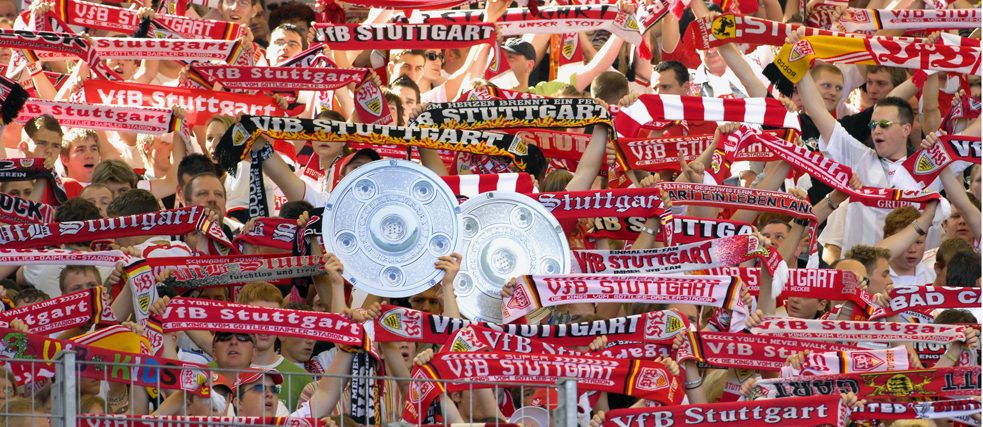 Fans des VfB Stuttgart mit der Meisterschale | Foto (Ausschnitt): © Picture Alliance/blickwinkel
Fans des VfB Stuttgart mit der Meisterschale | Foto (Ausschnitt): © Picture Alliance/blickwinkel
Germany’s Bundesliga was only established in 1963 – later than any other professional league in a conventional footballing country. Despite being relatively young, however, it is extremely popular: last season, Germany’s top division matches attracted average crowds of 44,657, making it the league with the highest average spectator numbers worldwide. For years, Borussia Dortmund has drawn the biggest crowds, averaging 79,496 fans per match in recent times. The Bundesliga also leads the field as compared with other sports – only the National Football League (NFL), the North American version with the egg-shaped ball, achieves higher stadium ticket sales.
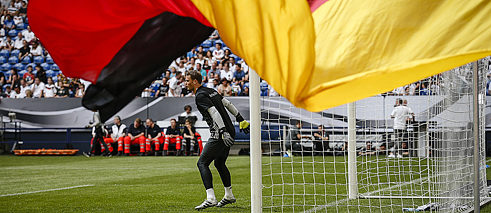
 1990 World Cup: in the penalty shoot-out, English centre-forward Gary Lineker (right) beats Bodo Illgner to make it 1:0, though England ultimately loses 4:3. | Photo (detail): © Picture Alliance/Frank Leonhardt
1990 World Cup: in the penalty shoot-out, English centre-forward Gary Lineker (right) beats Bodo Illgner to make it 1:0, though England ultimately loses 4:3. | Photo (detail): © Picture Alliance/Frank Leonhardt
 Munich fans demonstrate for the “50+1” rule to be preserved. | Photo (detail): © Picture Alliance/Sven Simon
Munich fans demonstrate for the “50+1” rule to be preserved. | Photo (detail): © Picture Alliance/Sven Simon
 Nach dem Finale gegen Brasilien: Die deutsche Frauennationalmannschaft freut sich 2007 über den Weltmeisterschaftstitel. | Foto (Ausschnitt): © Picture Alliance/Pressefoto Ulmer
Nach dem Finale gegen Brasilien: Die deutsche Frauennationalmannschaft freut sich 2007 über den Weltmeisterschaftstitel. | Foto (Ausschnitt): © Picture Alliance/Pressefoto Ulmer
 DDR-Stürmer Jürgen Sparwasser (2.v.l.) erzielt, vorbei am Abwehrspieler Berti Vogts (2.v.r.) und Torhüter Sepp Maier (l.), die 1:0-Führung gegen das BRD-Team. | Foto (Ausschnitt): © Picture Alliance/Werner Schulze
DDR-Stürmer Jürgen Sparwasser (2.v.l.) erzielt, vorbei am Abwehrspieler Berti Vogts (2.v.r.) und Torhüter Sepp Maier (l.), die 1:0-Führung gegen das BRD-Team. | Foto (Ausschnitt): © Picture Alliance/Werner Schulze
 Fans des VfB Stuttgart mit der Meisterschale | Foto (Ausschnitt): © Picture Alliance/blickwinkel
Fans des VfB Stuttgart mit der Meisterschale | Foto (Ausschnitt): © Picture Alliance/blickwinkel